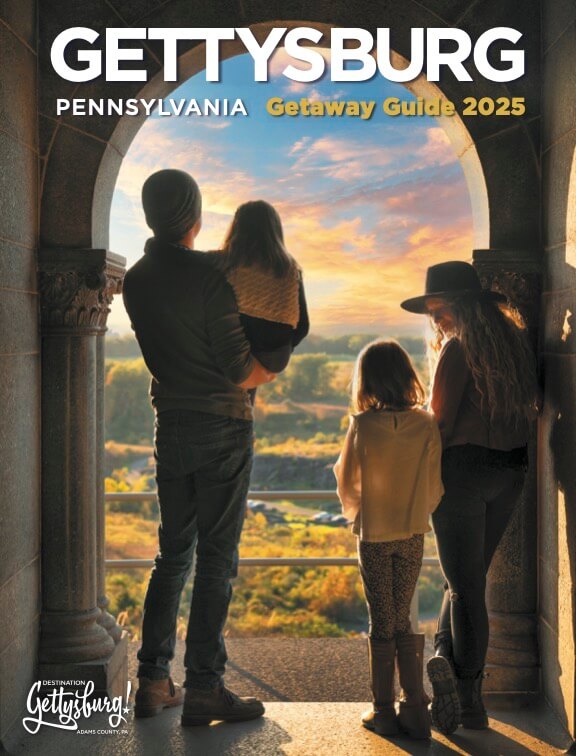Get the 2025 Gettysburg Getaway Guide
Check out our Getaway Guide online or have us send you one. Have an immediate question? Call us at 1.800.337.5015
Get the GuideOn November 19, 1863, President Abraham Lincoln delivered a 272-word speech to dedicate a new National Cemetery in Gettysburg, Pennsylvania, the site of the three day Battle of Gettysburg. Although both his time in Gettysburg and the speech that he made were brief, his words have echoed throughout history and his Gettysburg Address has become one of the most recognized and well-known speeches in American history. Today, you can not only witness Lincoln’s impact throughout the town of Gettysburg, you can actually walk in his footsteps. Check out these five locations to walk in Abraham Lincoln’s Gettysburg footsteps!
After hours of delays due to worn out equipment and railroad accidents, President Lincoln’s train arrived in Gettysburg after dark on the evening of November 18, 1863. The next day, he visited the train station again, this time to take the 6 p.m. train back to Washington, D.C. This train station, now known as the Gettysburg Lincoln Railroad Station, is what allowed the President to participate in the dedication of the Gettysburg National Cemetery. Without the quick and easy transit in and out of the town of Gettysburg, David Wills’ late invitation to the president to make “a few appropriate remarks” may not have been received in enough time for the President to respond or even arrive in time for the event.
After arriving in Gettysburg and departing his train, President Lincoln and a crowd of onlookers made their way one block south to the center of Gettysburg, then known as the Diamond and today known as Lincoln Square, to a large three-story red brick home owned by a prominent lawyer, David Wills. Wills was not only instrumental in the creation of the Gettysburg National Cemetery, personally purchasing the 17 acres of land the cemetery now encompasses, but he also personally invited the main speakers for the day, Edward Everett and President Abraham Lincoln.
While the inside of the house is currently closed, you can you can stand outside the David Wills House and see where President Lincoln stayed the night before delivering the Gettysburg Address, as well as learn about the legacy of his visit.
At 9:30 a.m. on November 19, 1863, President Lincoln and the other dignitaries formed a procession starting at the Diamond and ending at the new Gettysburg National Cemetery. Atop a chestnut colored horse, the President paraded southward throughout the town, first traveling along Baltimore Street, making a slight right onto Emmitsburg Road (today known as Steinwehr Avenue) and then turning left onto Taneytown Road before entering the cemetery grounds.
Today, this same one-mile route can be followed from the Wills House to the Taneytown entrance of the Gettysburg National Cemetery.
Since the fall of 1863, Cemetery Hill has been made up of not one, but two different cemeteries; Evergreen Cemetery and the Gettysburg National Cemetery. Evergreen, which had been the town cemetery since its creation in 1854, had played a pivotal role in the battle itself and now would be host to the speakers stand for the dedication of its new counterpart. Because the Gettysburg National Cemetery was still being filled with fresh graves on November 19, 1863, the ceremonies actually took place on the eastern side of the hill and not within the confines of today’s National Cemetery boundaries. It was here that Edward Everett, the great orator, statesman and main speaker for the event, spoke for more than two hours on remembrance of the past and of the dead. When President Lincoln rose to speak his 272 words for a mere two minutes, most of the crowd didn’t even realize the President had gotten up to speak at all.
Today you can visit both the Evergreen Cemetery and the Gettysburg National Cemetery from sunrise to sunset. While you will find numerous beautiful monuments dedicated to the soldiers who died here and to the President’s impactful words, you will not find any marker showing where the address was actually given. The priority on that day was to remember the men who fought there, not necessarily the men who dedicated it.
After the dedication ceremony and a late lunch back at Mr. Wills’ house, President Lincoln made one final stop before departing on the 6 p.m. train back to Washington, D.C. He had been invited to a patriotic meeting at the local Presbyterian Church at the corner of High and Baltimore streets. Before his trip, President Lincoln had asked to meet John Burns, a local veteran and hero of not just the Battle of Gettysburg, but the War of 1812, too. The famous 69-year-old Gettysburgian took up arms to defend his home from the invading Confederate Army on July 1 and was wounded three times during the battle. The two men did meet and sat together through the event, undoubtedly discussing Burns’ battle actions from that summer.
Although the building that stands at the corner of High and Baltimore Streets today is not the structure President Lincoln would have known, you can still visit the church and see the pew in which the President and John Burns sat in on November 19, 1863.

Check out our Getaway Guide online or have us send you one. Have an immediate question? Call us at 1.800.337.5015
Get the GuideDon’t miss a thing that’s going on in Gettysburg; sign up to receive our fun and informative travel planning newsletter.
Let's Go